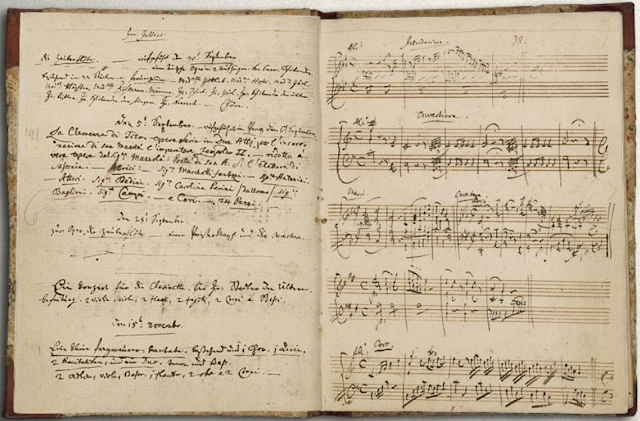Sketchbooks
 |
| Mozart: sketchbook |
I used to use a whiteboard for tracking and organizing projects, then two whiteboards. When it was time for a third whiteboard, I decided to put it all in a sketchbook. Using a sketchbook for recording projects is much more efficient and portable than whiteboards.
 |
| Anton Webern: sketchbook page for the string trio Op. 20; 3rd movement (1926) |
I maintain various sketchbooks, and use them every day. I prefer the larger zipper binder types, as I can add subject dividers, pens, and other related tools to each sketchbook.
I use black, red, and blue pens. Different colors for different elements, which I find helpful.
The purple sketchbook covers multiple areas and purposes. It includes subsections for compositional sketches, compositional diagrams, projects, new tunings, and much more. I use graph paper for some sketches, and manuscript paper for others. All the sketchbooks contain sections consisting of tablature manuscript that I've created using Finale with enough string lines for my multi-string instruments. The tablature pages contain staves for the strings and grand staff systems that are connected; in this manner I can notate the actual music and have the corresponding guitar tuning information for the instrument/tuning used for that composition. Using the tab manuscript I can also notate specific fingerings and harmonic structures for each tuning. This is important because each instrument is in a different tuning.
 |
| Mahler: Symphony No. 10 (1910) |
One sketchbook is for harmonic structures and scales with related guitar-family instrument fingerings and accompanying notes. One is for solo compositions. I keep those two sketchbooks up on music stands in front of me at all times when I'm shedding, as it's pretty common to have a compositional idea during practice sessions. Which, thanks to the sketchbooks, can quickly turn from shedding sessions into composing sessions. Due to this method, I composed over 60 new solo compositions in 2021.
Each sketchbook is divided into sections for each instrument. Additionally, each sketchbook is color-coded for its purpose; for example, the main sketchbook is purple.
 |
| Beethoven: Missa Solemnis; op. 123; 1823 |
The purple sketchbook covers multiple areas and purposes. It includes subsections for compositional sketches, compositional diagrams, projects, new tunings, and much more. I use graph paper for some sketches, and manuscript paper for others. All the sketchbooks contain sections consisting of tablature manuscript that I've created using Finale with enough string lines for my multi-string instruments. The tablature pages contain staves for the strings and grand staff systems that are connected; in this manner I can notate the actual music and have the corresponding guitar tuning information for the instrument/tuning used for that composition. Using the tab manuscript I can also notate specific fingerings and harmonic structures for each tuning. This is important because each instrument is in a different tuning.
 |
| Arnold Schoenberg: sketch for Theme and Variations; 5 December 1936 |
After migrating the whiteboards to the purple sketchbook, it seemed to mentally free me. For me, it was much more immediate to put something in the sketchbook than on the whiteboard; partially because I was running out of space on the whiteboards and was often forced to erase something to create space for new sketches. The sketchbooks are virtually unlimited, as I can keep adding blank manuscript, tablature, or graph pages to them as needed. And I can easily take the sketchbook with me; not so with whiteboards.
Not only is using a sketchbook for projects and compositions more efficient than whiteboards, I find that it makes me more prolific as physically sketching out an idea frequently results in spin-off ideas from that original one. There are compositions, tunings, recording projects, and at least two entire albums that would never have occurred had I not been using a sketchbook.
Migrating to multiple sketchbooks has proven to be a true sea change for me.
When I considered sketchbooks as a topic for a blog post, it made me want to research the sketchbooks of other composers and artists. I know Beethoven carried a small manuscript sketchbook with him on his nature walks, and many of those are still extant. Van Gogh worked from sketchbooks, as did Mozart. I've included a few sketchbook examples of composers and artists in this post.






Comments
Post a Comment